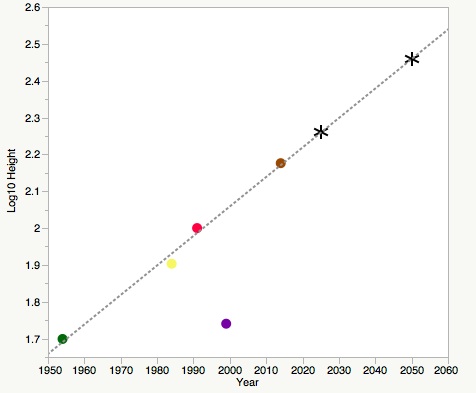You can probably tell that I'm really looking forward to the Godzilla reboot, due out May 16. I've posted this size chart before - it purports to show his (fluctuating) sizes through the years. Now Deep Sea News has some interesting analysis based on it:
In 1954 Godzilla was a mere 50 meters (164 ft). In the newest movie, Godzilla is estimated to be 150 meters (492 ft). For comparison the Empire State Building in New York City stands at 381 meters (1250 ft). Incarnations of Godzilla went from 13% of the height of the Empire State Building to nearly 40% of the height in just 60 years. It took cetaceans 55 million years to go from 2.5 meters (8.2 ft) to 30 meters (98 ft) in length.
This increase in size within a group animals through time, i.e. larger species constantly showing up on the evolutionary state, is a well known rule of biology. We refer to this pattern as Cope’s Rule, named after an American paleontologist Edward Drinker Cope. At broad levels, Cope’s Rule is definitely true. The start of life on this planet was microscopic and know we have whales and redwoods.
So how big will Godzilla be in 2050? Dot Physics calculates this to be 170 meters. That analysis, though, appears to be skewed by one significant outlier - the 1999 movie which put Godzilla's height at 55 meters, the second smallest in the set. Setting that outlier aside, the trend line straightens out: the author calculates that his height in 2050 at 288.4 meters, not 170 meters:
So why is Godzilla obtaining ever larger sizes with time? Skyscrapers. Skyscraper height has increased dramatically over the last century. For Godzilla to continue to plow through buildings in major metropolises, a more formidable size is needed. Of course this size change can only be evolutionarily adaptive if it changes the fitness of Godzilla, i.e. in the simplest case the number of offspring passed to the next generation. If Godzilla is able to topple buildings this might allow for greater acquisition of resources in this case food in the form of people. This would increase the lifespan of Godzilla allow for more reproduction or allow for greater amount of energy to be passed to the offspring increasing their rate of survival. Or perhaps toppling buildings is a sexual display that sexual partners cue on. Sexual selection!
The author had a previous post (calculating the amount that the Kaiju from Pacific Rim would need to eat on a daily basis) on the way in which an animal’s biology, everything from limb length, heart volume, lung capacity, territorial range, and urine production, all scale with body size. A 55K ton Godzilla, applying those calculations, would produce 151,436,928 gallons of urine per day.
I haven't done the math, but according to the Universal Law of Urination, every mammal takes ~21 seconds to empty its bladder. Yeah, I get that Godzilla is not a mammal, but there's probably some similar set of date for reptiles/amphibians. It does make one wonder about the implications of the amount of urine Godzilla will be producing, and where it'll all end up.
Related posts:
The Art of Destruction - new art book from the about-to-be-released Godzilla movie, plus a bunch of old-time Godzilla movie posters.
U.S. Military Expert Unveils a Strategy for Deploying Godzilla in War.
Universal law of urination found in mammals.
Does every species get around 1 billion heartbeats per lifetime?
More at Deep Sea News and Wired.


No comments:
Post a Comment